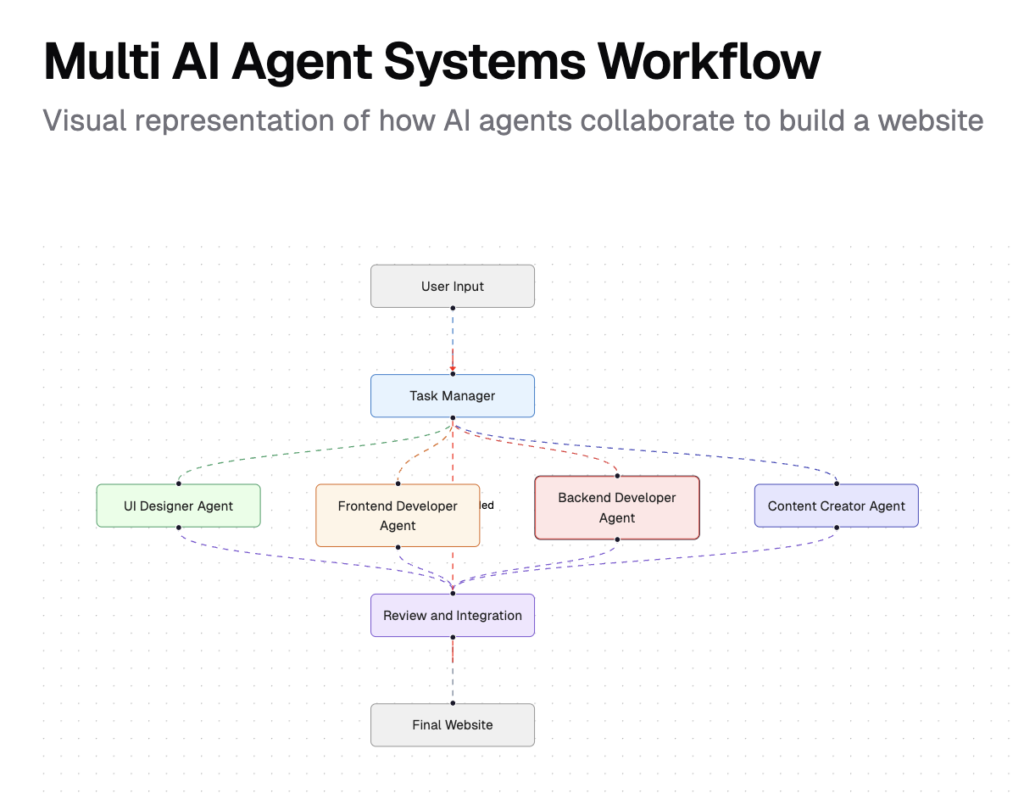I. What are AI Agents?
AI agents represent a significant leap beyond traditional software, introducing autonomous, intelligent behavior to systems that interact with both their environment and users. At their core, AI agents are designed to perceive their surroundings, make decisions, and act upon those decisions to achieve specific goals. This fundamental attribute sets them apart from conventional software, which typically operates based on strict, pre-defined rules without the capability for learning or adaptation.
Understanding AI Agents:
- Definition and Concept: AI agents are computer programs endowed with the ability to autonomously perform tasks or make decisions based on data input, learning from interactions rather than relying solely on static programming.
- Difference from Traditional Software: Unlike traditional software that follows explicit instructions for every operation, AI agents utilize techniques like machine learning to adapt and improve their performance over time, providing dynamic responses to new challenges.
With this foundational understanding of what AI agents are and how they differ from traditional software, we can better appreciate the nuances of the different types of AI agents explored in the next section.
II. Types of AI Agents
AI agents can be categorized based on their level of autonomy and the complexity of the tasks they perform. Understanding these types can help in choosing the right AI agent for specific applications, ensuring optimal performance and efficiency.
Reactive Agents
- Definition: Reactive agents are the simplest form of AI agents. They operate based on current perceptions, reacting to changes in their environment without using an internal model of the world.
- Example: A simple cleaning robot that reacts to dirt detected in its path.
Proactive Agents
- Definition: Proactive agents are more advanced; they can form goals and act to achieve them. They are capable of taking initiative rather than merely responding to the environment.
- Example: Personal assistant apps that suggest tasks based on user habits and preferences.
Hybrid Agents
- Definition: Hybrid agents combine features of both reactive and proactive types. They can respond to immediate inputs while also planning for future goals.
- Example: Advanced autonomous vehicles that navigate traffic while adjusting routes based on expected traffic conditions.
This overview of AI agent types not only enhances our understanding of their functionalities but also showcases their potential to adapt to diverse applications, from simple mechanical tasks to complex decision-making processes. This adaptability is key as we explore deeper into how these agents operate in the following section.
III. How AI Agents Work
AI agents enhance the functionality of small businesses by automating tasks, improving decision-making processes, and interacting dynamically with customers and environments. Understanding the mechanics of AI agents—perception, decision-making, and action—can significantly boost the operational efficiency of a small business.
Perception
- Overview: AI agents collect data through various inputs like customer feedback, online interactions, or physical sensors in the business environment. This information forms the basis for all subsequent actions.
- Example: A local bookstore employs an AI system to monitor which genres and titles customers ask for most frequently, using this data to adjust its stock.
Decision-Making
- Overview: From the data gathered, AI agents identify patterns and insights that help in making informed decisions about stock levels, customer engagement strategies, and more.
- Example: A coffee shop uses AI to analyze customer purchase patterns and determine the optimal times for promotional offers on different types of drinks.
Action
- Overview: After decisions are made, AI agents implement actions, whether interacting directly with customers or managing internal operations.
- Example: A flower shop employs an AI-powered solution that schedules deliveries based on weather conditions and customer availability, optimizing delivery routes and times.
Integration with Other Technologies
- Overview: Small businesses benefit from integrating AI with other technologies like cloud computing for data management and IoT for enhanced connectivity.
- Example: A pet store integrates its AI inventory management system with IoT-enabled feeders to track pet food sales and automatically reorder stock when supplies run low.
By utilizing AI agents, small businesses can automate complex processes, tailor services to customer preferences, and manage resources more efficiently, freeing up time to focus on growth and customer service.
IV. Applications of AI Agents in Small Businesses
AI agents offer a variety of practical applications that can revolutionize how small businesses operate, enhancing efficiency and improving customer experiences. Here’s how AI agents are being used across different sectors:
Customer Service
- Overview: AI agents can handle customer inquiries and support tasks, reducing response times and freeing up human employees for more complex issues.
- Example: A local craft store uses an AI chatbot on its website to answer common questions about product availability, store hours, and crafting tips, ensuring customers receive immediate assistance.
Inventory Management
- Overview: AI agents help manage inventory by predicting stock needs based on historical sales data, seasonal trends, and other factors.
- Example: A boutique fashion outlet employs AI to forecast upcoming trends and adjust inventory orders accordingly, preventing overstock and stockouts.
Marketing and Sales
- Overview: AI can analyze customer behavior and preferences to tailor marketing campaigns and suggest targeted promotions.
- Example: A family-run restaurant uses AI to analyze which dishes are most popular on different days of the week and tailors its email marketing to promote these favorites on slower days.
Operations Optimization
- Overview: AI agents streamline operations by automating routine tasks and optimizing business processes.
- Example: A small dental office uses AI scheduling tools to manage appointment bookings, automatically adjusting the schedule based on patient cancellations and no-shows to maximize efficiency.
These applications demonstrate the power of AI agents in transforming small businesses, making them more responsive, efficient, and attuned to the needs of their customers. By adopting AI technology, small business owners can leverage these tools to gain a competitive edge and enhance their operational capabilities.
V. Challenges and Ethical Considerations
While AI agents offer substantial benefits to small businesses, they also come with challenges and ethical considerations that must be managed to ensure responsible usage and trust among consumers.
Data Privacy and Security
- Overview: The use of AI requires handling significant amounts of data, which raises concerns about privacy and data security. Small businesses must adhere to data protection regulations and ensure that customer information is secure.
- Example: A neighborhood fitness center using AI to track client workout progress needs robust security measures to protect sensitive health data from breaches.
Bias and Fairness
- Overview: AI systems can inadvertently perpetuate biases if not properly trained or if the data used is skewed. This can lead to unfair treatment of customers or erroneous business decisions.
- Example: A local beauty salon using AI to recommend products must ensure that the algorithm is free from biases that could favor one customer group over others, ensuring fairness in customer service.
Transparency and Accountability
- Overview: Businesses must maintain transparency about how AI agents are used and be accountable for their decisions, especially when those decisions impact customer interactions and business operations.
- Example: A family-owned bookstore must be clear with customers about how it uses AI to make recommendations and manage personal data, fostering trust and openness.
Dependence and Skill Gaps
- Overview: Relying heavily on AI can lead to dependency, which becomes problematic if systems fail. Additionally, there can be a skill gap in effectively managing AI technologies.
- Example: A small gourmet grocery store that uses AI for inventory and ordering must have contingency plans and train staff to handle tasks manually if the AI system temporarily goes offline.
Addressing these challenges requires careful planning, ongoing monitoring, and adherence to ethical standards to fully harness the advantages of AI while minimizing potential downsides. As AI technology continues to evolve, staying informed and prepared is essential for any business looking to implement AI successfully.
VI. The Future of AI Agents
The future of AI agents promises enhanced capabilities and broader accessibility, driving innovation and efficiency in operations. As technology progresses, these tools will become even more integrated into daily business activities, offering new opportunities for growth.
Increasing Accessibility
- Overview: Technological improvements and cost reductions are making AI tools more accessible. This democratization allows enterprises of all sizes to leverage advanced capabilities previously limited to larger organizations.
- Example: Developers are creating user-friendly AI analytics tools that require minimal technical knowledge to implement, making sophisticated data analysis available to more users.
Enhanced Customization
- Overview: Future AI systems will offer greater customization, allowing users to tailor features to their specific needs and industry demands.
- Example: Bespoke AI solutions are being developed for sectors like retail and hospitality, featuring custom interfaces and functionalities for these particular markets.
Greater Integration
- Overview: AI will integrate more seamlessly with existing systems and workflows, enhancing efficiency and simplifying the adoption process.
- Example: Upcoming AI tools will directly integrate with common business platforms like point-of-sale systems and CRM software, facilitating smoother and quicker implementation.
Proactive Innovations
- Overview: AI agents will increasingly feature proactive capabilities, anticipating needs and addressing issues before they become problematic.
- Example: Advanced AI systems could predict seasonal demand fluctuations in businesses and automatically adjust resource allocations to optimize operations.
These advancements position businesses to leverage AI for not only current success but also future readiness, ensuring they remain competitive in a rapidly evolving market landscape.
V. Autonomous Agents
Autonomous agents are a sophisticated subset of AI agents that operate independently, making decisions and performing tasks without human intervention. These agents are particularly valuable in scenarios requiring rapid response and adaptability.
Key Features
- Overview: Autonomous agents are equipped with the capability to analyze their environment, learn from interactions, and make decisions based on real-time data.
- Example: An autonomous delivery drone navigates cityscapes to deliver packages, dynamically adjusting its route based on weather conditions and traffic updates.
Benefits
- Overview: The main advantage of autonomous agents lies in their ability to operate continuously and efficiently, reducing the need for constant human oversight and enabling businesses to allocate human resources to more strategic tasks.
- Example: Automated inventory robots in a warehouse perform stock checks and reorder items autonomously, allowing staff to focus on customer service and order fulfillment.
Challenges
- Overview: While they offer significant benefits, autonomous agents also present challenges such as the need for sophisticated programming, maintenance, and ensuring safety and ethical use in all operations.
- Example: Ensuring that autonomous agents like AI-driven security cameras respect privacy rights requires careful programming and compliance with data protection laws.
Integration with Business Operations
- Overview: For successful integration, businesses must ensure that autonomous agents are compatible with existing systems and that staff are trained to work alongside these advanced technologies.
- Example: A small cafe might use an autonomous coffee-making robot that syncs with their sales system to track ingredient levels and customer preferences, ensuring efficiency and personalized service.
This section on autonomous agents highlights their capabilities and the considerations businesses must keep in mind to effectively integrate and benefit from this technology.




